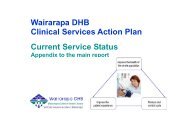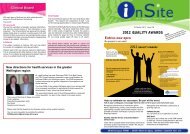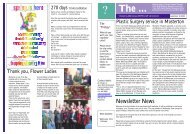Te Arawhata Totika - Wairarapa DHB
Te Arawhata Totika - Wairarapa DHB
Te Arawhata Totika - Wairarapa DHB
Create successful ePaper yourself
Turn your PDF publications into a flip-book with our unique Google optimized e-Paper software.
The objective of Tikanga Best Practice is that tikanga<br />
becomes embedded in clinical practice. Staff training<br />
in the application of Tikanga Best Practice is a<br />
necessity. ‘In exercising the principles of the policy it<br />
is anticipated that the awareness and confidence of<br />
the health workforce may be raised and in doing so<br />
staff may demonstrate consideration of wider cultural<br />
needs and expec tations’ (ibid, nd:3). Furthermore, this<br />
policy is a framework to bring about a positive and<br />
robust workforce that demonstrates and incorporates<br />
the intrinsic worth of dignity, respect, awareness,<br />
confidence, consideration and quality when working<br />
alongside Mäori service users, their whänau and<br />
all other peoples using wDhB services as they<br />
move through their healing and recovery journeys.<br />
<strong>Wairarapa</strong> District Health Board<br />
Strategic Plan 2005<br />
The wairarapa District health Board Strategic Plan<br />
sets out the priorities and strategic directions that will<br />
guide the wDhB over the next five to ten years. The<br />
strategic plan focuses on reducing disparities and<br />
inequalities for four groups in our population: Mäori,<br />
people in lower socio-economic groups, older people<br />
and children and youth (wairarapa DhB, 2005:1).<br />
Furthermore, the plan recognises mental illness and<br />
addictions as one key priority area which needs a<br />
specific focus to reduce incidence and impact.<br />
The strategic plan in its striving to reduce the<br />
disparities between Mäori and non-Mäori intends<br />
to create an environment which is conducive to<br />
the needs of Mäori. The wDhB intends to:<br />
• work more collaboratively alongside the wider<br />
wairarapa Mäori community and NGO sector<br />
• ensure Mäori participation at all levels of the<br />
health and disability sector<br />
• make mainstream service provision culturally<br />
effective, accessible and appropriate for<br />
Mäori tängata whäiora and their whänau<br />
<strong>Wairarapa</strong> District Health Board District<br />
Annual Plan 2008/09<br />
The wDhB District Annual Plan has identified<br />
seven wairarapa health gain priorities for 2008/09.<br />
Two key areas that have been identified are:<br />
• Improving the health of Mäori<br />
• reducing the incidence of mental illness and addictions<br />
Furthermore the DAP has identified five over arching<br />
strategic directions or themes to address these key<br />
priorities, they are summarised as:<br />
• Working collaboratively across <strong>Wairarapa</strong><br />
health sector<br />
• Using holistic approaches to health service delivery<br />
• Continually striving for excellence<br />
it is an identified reality that Mäori continue to<br />
have poorer health than all other ethnic groups<br />
regionally and nationally. Although there have<br />
been health gains in some areas, Mäori health<br />
continues to remain a national priority. Mäori are<br />
less likely to access appropriate health services,<br />
even though their need is greater. ‘<strong>DHB</strong>s have<br />
statutory responsibilities to advance Mäori health<br />
and to reduce disparities between Mäori and<br />
nonMäori’ (<strong>Wairarapa</strong> <strong>DHB</strong>, 2007). An identified<br />
pathway forward for addressing these issues<br />
of concern is the development in the support of<br />
whänau ora and the use of Mäori models of health.<br />
The DAP has identified a number of priorities<br />
to achieve throughout the 2008 – 2009 period.<br />
within the parameters of their identified priorities<br />
such things have been highlighted as:<br />
• Services to be more effective for Mäori<br />
• W<strong>DHB</strong> Treaty of Waitangi policy is a key<br />
component in the delivery of all health services<br />
in wairarapa<br />
• Mäori participation across the <strong>DHB</strong> recruit ment<br />
processes, mainstream staff development and<br />
the redevelopment of provider arm services<br />
• Improving mainstream effectiveness<br />
<strong>Wairarapa</strong> Health Needs<br />
Assessment 2008<br />
The New Zealand health and Disability Act 2000<br />
requires District health Boards (DhBs) to review<br />
and update their health Needs Assessment (hNA)<br />
for their district populations at least every three<br />
years to inform their strategic plan updates<br />
The Ministry of health (2000) defines a health<br />
Needs Assessment as:<br />
“The assessment of the population’s capacity<br />
to benefit from health care services, prioritised<br />
according to effectiveness, including<br />
cost-effective ness, and funded within available<br />
resources.”<br />
The health Needs Assessment looks at the health<br />
status and needs of the wairarapa pop ulation and<br />
it contains information that guides planners who set<br />
priorities and strategies for the future. it supports<br />
the develop ment and review of the District Strategic<br />
Plan which is currently reviewed every three years.<br />
This is the first time a separate document has<br />
been produced specifically for wairarapa Mäori.<br />
<strong>Te</strong> <strong>Arawhata</strong> Tötika Cultural Competency Framework<br />
29







